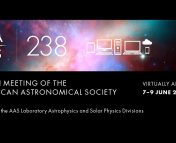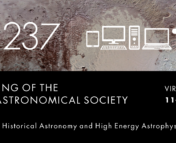In this series of posts, we sit down with a few of the keynote speakers of the 238th AAS meeting to learn more about them and their research. You can see a full schedule of their talks here, and read our other interviews here!

Interdisciplinary research may seem like a topic that has recently gained immense traction in the scientific community. However, for Dr. Tabbetha A. Dobbins, interdisciplinarity has been a key component of her approach to research from day one. A professor of physics at Rowan University, Dobbins works at the intersection of materials science, condensed matter physics, and energy science – studying techniques to improve hydrogen storage for fuel cells as an alternative to electricity generated using fossil fuels. In parallel, Prof. Dobbins is a founding member of the American Institute of Physics TEAM-UP task force, aimed at increasing the representation of African American undergraduate students in physics and astronomy.
Her plenary talk at #AAS238, titled “The Time is Now: Findings from TEAM-UP Report to Increase the Number of African Americans with Bachelor’s Degrees in Physics and Astronomy”, will focus on the work of the original TEAM-UP task force and the lessons learned from it as well as recommended action items for physics and astronomy departments.
The Time is Now
According to Prof. Dobbins, the need of the hour is for departments to find ways to improve their environment so Black students can flourish, rather than viewing the students as needing improvement. “We decided early on that the TEAM-UP report was not a “fix the students” exercise, but rather a “fix the environment” exercise.” This is a view she has held ever since first joining the taskforce, which was convened in December 2017 and worked for two years to really answer the question of what makes a department strong in retaining African American students. Dobbins emphasises that the main takeaways from TEAM-UP can be distilled down into the “five factors” highlighted in the report as being essential to helping Black students thrive in our field:
- Belonging – students believing that they have a place in the community
- Physics Identity – students identifying as physicists and astronomers
- Academic Support – teaching and mentoring provided by faculty, postdocs, and graduate students
- Personal Support – aimed at relieving individual stressors, financial hardship, etc
- Leadership & Structure – making sure there is buy-in from department and university leadership to institutionalise and sustain progress
It was after giving a plenary talk focusing on her background and experiences as a Black physicist at a CU2MiP conference in 2017 that Dobbins was invited to volunteer for TEAM-UP. She points out that the ten founding members consist of eight physicists and two sociologists. This inclusion of sociologists and education researchers from day one was crucial, according to Dobbins, because while physicists and astronomers are comfortable with statistics and data analysis, they don’t have the background or training to analyse issues from a sociological and human-centric perspective. “This is advice for faculty members … I would say it’s important to slow down and engage with your[sic] sociologists on your campus – allow them to help you collect the data and to really understand the true factors for why the demographic numbers are in a certain way [for minority students].”
Even outside of the TEAM-UP collaboration, Prof. Dobbins has long been invested in and refining her approach to mentoring students. Since Rowan University is a heavily undergraduate-serving institution, her research group has historically been composed solely of undergrads. “We didn’t even have our first grad student join the lab until last year!” she exclaims. Her approach to being a research adviser is to make sure the students have enough independence on their project and have their own questions that they’re trying to answer. She strongly believes that giving students ownership of their projects and allowing them to design their own experiments, even if just over ten weeks in the summer, is vital to developing their senses of Belonging and Physics Identity, and “[…] is an important part to being a scientist; … being able to seek answers to your own questions [is] just as important as it is to be able to work in a team.”
“I’m very happy that I stayed in academia”
Dr. Dobbins started her academic career at Lincoln University in Pennsylvania – an HBCU. She recalls that Lincoln helped her develop her physics identity early on through individualised attention and academic as well as personal support. It was only after working with TEAM-UP, however, that she realised the extent to which HBCUs all over the country are already providing students with many of the five factors identified by the task force. Dobbins mentions that starting at an HBCU and only later seeing that there were things in her environment back then that led to her success really made things come full circle for her. She points out HBCUs as already providing the kind of environment and educational model that other physics and astronomy departments nationwide could learn from.
Although she had originally wanted to pursue computer science (CS), citing her high school CS teacher as being a huge inspiration, Dobbins switched to physics during undergrad due to Lincoln not having as good of a CS department. After doing grad school in materials science and a postdoc stint at NIST, her first faculty position was in a physics department that valued material science. Since then she has continued to be at physics departments, including at Rowan currently. “So really I was trying to run away from physics, and here I am back in physics,” chuckles Dobbins.
At Rowan, her current research efforts focus on using sodium aluminium hydride (SAH) as a storage material within the context of hydrogen-powered fuel cells. The end goal is to provide a source of hydrogen to Proton-Exchange Membranes (PEM), which are then used to generate electricity. Storing the hydrogen fuel in tanks is tricky, however, and materials like SAH offer a convenient alternative. Dobbins’ group specifically focuses on using catalysts and nano-confinement techniques to enable the liberation of hydrogen from SAH at low enough temperatures that this technique results in a net production of clean energy.
Citing her reasons for choosing a position at Rowan University, Prof. Dobbins explains that the institution was already doing a lot of the things for students that the TEAM-UP report found to be critical. Even in a predominantly white institution and physics department at Rowan, the proactiveness of department leadership in catering to the needs and belonging of Black students really appealed to her. She points out the similarity in the mentoring philosophy of her department to her own: “[…] we need to recognise that students are not just students, but whole people, so the things that feed their wellness are just as important as academics.”
To learn more about Prof. Dobbins’ work with TEAM-UP, check out her plenary talk at 3:10PM ET on Monday, 7th June at #AAS238!

Astrobite edited by: Ellis Avalone
Featured image credit: American Astronomical Society



